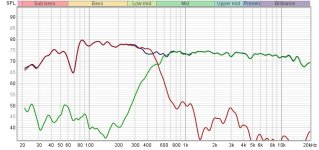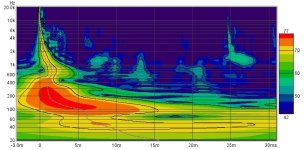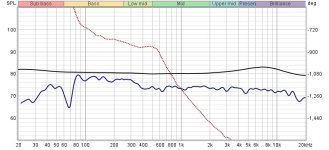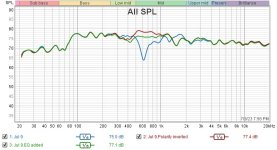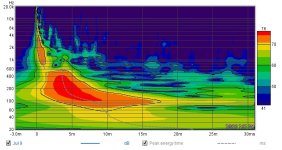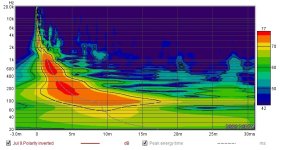As a point of reference, below you will see the raw (uncorrected) transfer function response of an Axi2050 driver mounted on a K-402 horn (measured ~15 degrees off-axis):

Chris
Chris
here are some REW results. You can see the buldge just above the Xo point. This always happens, with the coresponding time lag. Currently using no "named" crossovers, both slopes constructed from PEQ. Always have phase dropping at XO. Currently have High frequency driver set at delay of 3.322ms. This seems like a lot of delay, but less delay and the woofer lags behind even further. I have done hundreds of crossover, delay combinations and this is the best for having the least woofer "time lag" Phase is always 1000 to 1500 Degrees.
This is way I am interested in FIR filters, the possibilty of better timing and phase.
Any comments welcome, Ted
This is way I am interested in FIR filters, the possibilty of better timing and phase.
Any comments welcome, Ted
Attachments
I should add, the large dip at 70 hz I’m thinking is speaker boundary interference. That’s another, I think separate, issue I’m exploring.
I see dips in your combined response at 400 and ~650Hz. I don't really see a bulge. It doesn't look like your driver responses are correct around the crossover region. I see a sharper corner in your woofer's rolloff than in the tweeter's. I also see a dip just above 500Hz in the tweeter roll off. Also you have different passband levels from each driver that you're trying to match up through the crossover. Personally I have found it a lot easier with digitally controlled systems to put the drivers at the same passband level and target a flat response, get the individual driver response to match a target curve that I want and that I know will sum flat (for example Linkwitz-Riley 4th order), then set a delay on one of the drivers if needed due to physical alignment to get the crossover to sum correctly. You can also check flipping one of the driver's polarities to verify a good cancellation. Then if you want a sloping system response add a filter that effects both drivers with the same response. This will prevent odd phase issues around crossover which make it harder to sort out the summing of your drivers. Also, remember that since your system is a bandpass system, there will be a phase shift associated with that even if you have a perfectly flat response from a single driver in between the frequency extremes. Adding a minimum phase crossover will also cause a phase shift, but this isn't really a problem in my experience. You can reduce or eliminate the phase shift by making a non minimum phase FIR filter for the system at the cost of delay, but in my experience I haven't been able to hear a difference. Making a minimum phase FIR filter for each driver can make it easier to sort out all the wiggles in your response and get your exact acoustic target responses, but you can also do it just fine with PEQ filters unless you have a really rough response to start with and run out of DSP resources.
John,
I grew with everything you’re saying, but I’ve done so many iterations, some summing flatter than others, but always with the “bulge” above the XO, (seen in the spectrogram) There is always a corresponding low energy indication before the peak volume line,
(blue dot on left at 750hz). This “bulge” is what confuses me, is it phase related? Has anybody experienced this? I’ve tried lowering amplitude at 500-800hz, which helps, but then there is a large amplitude dip. Could it be very strong, very early reflection?
I grew with everything you’re saying, but I’ve done so many iterations, some summing flatter than others, but always with the “bulge” above the XO, (seen in the spectrogram) There is always a corresponding low energy indication before the peak volume line,
(blue dot on left at 750hz). This “bulge” is what confuses me, is it phase related? Has anybody experienced this? I’ve tried lowering amplitude at 500-800hz, which helps, but then there is a large amplitude dip. Could it be very strong, very early reflection?
You'll definitely get some ripple in the response above and below the crossover when your driver responses aren't right and if your time delay is off. Beyond that, I don't know what 'bulge' in the response you're referring to. Maybe circle it on your response plot? I'd say overall you have a dip in the response around the crossover region.
Oh, I never use those plots - didn't even look at that. Your response is messed up around the crossover. I'd focus on fixing that first as that's going to have a much larger impact on what you hear.
Interesting...Oh, I never use those plots - didn't even look at that.
As an excursion: turn off all delays on the bass and midrange channels, then turn on a first order (Butterworth type in the Xilica XConsole app) for bass and midrange channels--then post the spectrogram after those changes. It should then look like the spectrograms that I posted in post #17.Always have phase dropping at XO.
Chris
I would recommend loopback measurement--as that looks exactly like your earlier measurements from a couple of years ago. If you truly have zero delays set on the output channels, it looks like there is a soundcard/digital bus/DAC issue, or a microphone issue. If the Xilica is performing nominally, zero delays and first order crossover should give you a straight up-and-down spectrogram--down to at least 200 Hz.here is 6db Butterworth, Zero delays. Blue-original. Red -polarity inverted. Green-EQ applied
First Spectogram-original. Second with polarity inverted
Chris
@Vds1000
To your original question: I use Acourate for the digital crossovers and room correction (and time alignment, etc) and Lynx Hilo as multichannel DAC and ADC. Acourate allows finite impulse response (FIR) filters. Audiolense is excellent too, as I understand it. Hilo is very flexible and I started using it as 2-channel, then went to 4 (subs plus floorstanders with their passive xo), then 6-channel, currently 8-channel. Having ADC in the same DAC unit is recommended by Uli Brueggemann, the man behind Acourate, to avoid clock drfting. Other good options are Lynx Aurora (Hilo has better converters though), Prism Titan, Merging Hapi (this might be my next step/destination). You have other brands too that likely have suitable units, such as Focusrite. For taking measurements I use a Dayton EMM-6 mic and a Focusrite Solo card as mic preamp into Hilo analog input. USB mics work but aren't recommended as best option because of the clock drifting mentioned above.
From the Hilo I drive the amps.
I decided to go only with digital audio, although I know someone who has his turntable connected to the Hilo analog inputs and uses the correction with Acourate filters.
For playback I use Roon as control app, currently doing the convolution inside Roon with the Acourate filters, sending the 8 channels over ethernet to a light Roon Bridge computer connected to Hilo. I'm in the process of trying HQPlayer again: use Roon as control, sending the files into HQPLayer for convolution and playback (I tried this long ago before Roon had convolution available).
Acourate is very powerful. It's a steep learning curve but there are resources available (see Mitch Barnett's articles on computeraudiophile from about 10 years ago, the Mitch's ebook), plus Uli is quite willing to help. Your understanding seems to be pretty good already, so I would think your learning curve won't feel so steep either.
I hope this helps.
To your original question: I use Acourate for the digital crossovers and room correction (and time alignment, etc) and Lynx Hilo as multichannel DAC and ADC. Acourate allows finite impulse response (FIR) filters. Audiolense is excellent too, as I understand it. Hilo is very flexible and I started using it as 2-channel, then went to 4 (subs plus floorstanders with their passive xo), then 6-channel, currently 8-channel. Having ADC in the same DAC unit is recommended by Uli Brueggemann, the man behind Acourate, to avoid clock drfting. Other good options are Lynx Aurora (Hilo has better converters though), Prism Titan, Merging Hapi (this might be my next step/destination). You have other brands too that likely have suitable units, such as Focusrite. For taking measurements I use a Dayton EMM-6 mic and a Focusrite Solo card as mic preamp into Hilo analog input. USB mics work but aren't recommended as best option because of the clock drifting mentioned above.
From the Hilo I drive the amps.
I decided to go only with digital audio, although I know someone who has his turntable connected to the Hilo analog inputs and uses the correction with Acourate filters.
For playback I use Roon as control app, currently doing the convolution inside Roon with the Acourate filters, sending the 8 channels over ethernet to a light Roon Bridge computer connected to Hilo. I'm in the process of trying HQPlayer again: use Roon as control, sending the files into HQPLayer for convolution and playback (I tried this long ago before Roon had convolution available).
Acourate is very powerful. It's a steep learning curve but there are resources available (see Mitch Barnett's articles on computeraudiophile from about 10 years ago, the Mitch's ebook), plus Uli is quite willing to help. Your understanding seems to be pretty good already, so I would think your learning curve won't feel so steep either.
I hope this helps.
Ok, we’ll I turned off my Xilica for 24hrs. Turned it back on and now everything is good. I’m so confused. The phase is FLAT to from 40-8000hz. The timing is within 1 ms from 100-20,000hz. Even my 10db dip at 70hz,( I thought it was speaker boundary interference) is gone. I really don’t understand. I guess leaving Xilica on for 8 months or so did not help.
And the sound is noticeable better. Definitely better. I’m dumbfounded
And the sound is noticeable better. Definitely better. I’m dumbfounded
- Home
- Loudspeakers
- Multi-Way
- DSP hardware experience/opinions needed
